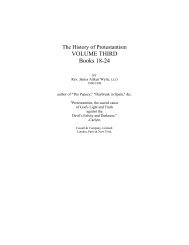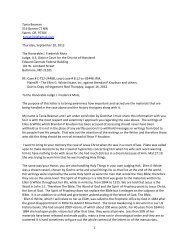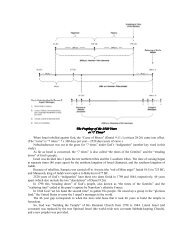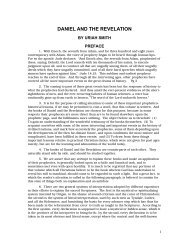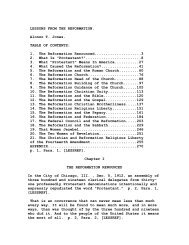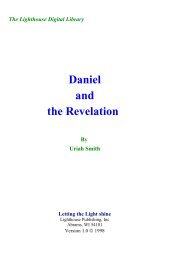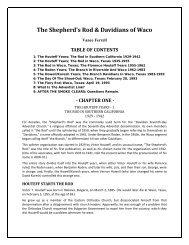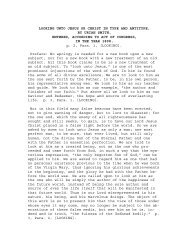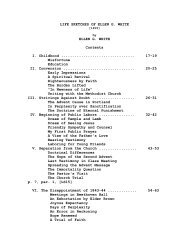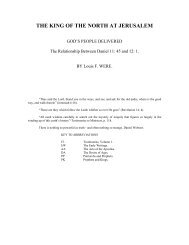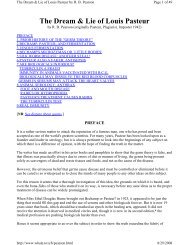- Page 1 and 2: The Greatest Conspiracy Satan’s W
- Page 3 and 4: A Word To the Reader Historical and
- Page 5 and 6: -v- Preface history of apostasy in
- Page 7 and 8: Physical Blindness Neil Livingston
- Page 9 and 10: -ix- Neil Livingston’s Autobiogra
- Page 11 and 12: Chapter 1 Holy Flesh and Celebratio
- Page 13 and 14: Chapter 1 Holy Flesh and Celebratio
- Page 15 and 16: Chapter 1 Holy Flesh and Celebratio
- Page 17 and 18: Chapter 1 Holy Flesh and Celebratio
- Page 19 and 20: Chapter 1 Holy Flesh and Celebratio
- Page 21 and 22: Chapter 1 Holy Flesh and Celebratio
- Page 23 and 24: Chapter 1 Holy Flesh and Celebratio
- Page 25 and 26: Chapter 1 Holy Flesh and Celebratio
- Page 27 and 28: Chapter 2 The Birth of An Image dis
- Page 29 and 30: Chapter 2 The Birth of An Image Whi
- Page 31: Chapter 2 The Birth of An Image A.
- Page 35 and 36: Chapter 2 The Birth of An Image No
- Page 37 and 38: Chapter 2 The Birth of An Image thr
- Page 39 and 40: Chapter 2 The Birth of An Image ART
- Page 41 and 42: Chapter 2 The Birth of An Image “
- Page 43 and 44: Chapter 2 The Birth of An Image “
- Page 45 and 46: Chapter 3 Early Ecumenical Aspirati
- Page 47 and 48: Chapter 3 Early Ecumenical Aspirati
- Page 49 and 50: Chapter 3 Early Ecumenical Aspirati
- Page 51 and 52: Chapter 3 Early Ecumenical Aspirati
- Page 53 and 54: Chapter 3 Early Ecumenical Aspirati
- Page 55 and 56: Chapter 3 Early Ecumenical Aspirati
- Page 57 and 58: Chapter 4 Church Fathers, and the C
- Page 59 and 60: Chapter 4 Church Fathers, and the C
- Page 61 and 62: Chapter 4 Church Fathers, and the C
- Page 63 and 64: Chapter 4 Church Fathers, and the C
- Page 65 and 66: Chapter 4 Church Fathers, and the C
- Page 67 and 68: Chapter 4 Church Fathers, and the C
- Page 69 and 70: Chapter 5 A False Bible Seventh-day
- Page 71 and 72: Chapter 5 A False Bible ibid., Art.
- Page 73 and 74: Chapter 5 A False Bible interesting
- Page 75 and 76: Chapter 5 A False Bible this libera
- Page 77 and 78: Chapter 5 A False Bible contemporar
- Page 79 and 80: Chapter 5 A False Bible Chapter 6 M
- Page 81 and 82: Chapter 6 Modern Translations and S
- Page 83 and 84:
Chapter 6 Modern Translations and S
- Page 85 and 86:
Chapter 6 Modern Translations and S
- Page 87 and 88:
Chapter 6 Modern Translations and S
- Page 89 and 90:
Chapter 6 Modern Translations and S
- Page 91 and 92:
Chapter 6 Modern Translations and S
- Page 93 and 94:
Chapter 6 Modern Translations and S
- Page 95 and 96:
Chapter 7 A Creed and A Church Manu
- Page 97 and 98:
Chapter 7 A Creed and A Church Manu
- Page 99 and 100:
Chapter 7 A Creed and A Church Manu
- Page 101 and 102:
Chapter 7 A Creed and A Church Manu
- Page 103 and 104:
Chapter 7 A Creed and A Church Manu
- Page 105 and 106:
Chapter 7 A Creed and A Church Manu
- Page 107 and 108:
Chapter 7 A Creed and A Church Manu
- Page 109 and 110:
Chapter 7 A Creed and A Church Manu
- Page 111 and 112:
Chapter 7 A Creed and A Church Manu
- Page 113 and 114:
Chapter 10 A Warning, and It’s Re
- Page 115 and 116:
Chapter 10 A Warning, and It’s Re
- Page 117 and 118:
Chapter 10 A Warning, and It’s Re
- Page 119 and 120:
Chapter 10 A Warning, and It’s Re
- Page 121 and 122:
Chapter 10 A Warning, and It’s Re
- Page 123 and 124:
Chapter 10 A Warning, and It’s Re
- Page 125 and 126:
Chapter 10 A Warning, and It’s Re
- Page 127 and 128:
Chapter 10 A Warning, and It’s Re
- Page 129 and 130:
Chapter 10 A Warning, and It’s Re
- Page 131 and 132:
Chapter 10 A Warning, and It’s Re
- Page 133 and 134:
Chapter 10 A Warning, and It’s Re
- Page 135 and 136:
Chapter 10 A Warning, and It’s Re
- Page 137 and 138:
Chapter 11 The Fin own kindling. An
- Page 139 and 140:
Chapter 11 The Fin atonement on the
- Page 141 and 142:
Chapter 11 The Fin the view which h
- Page 143 and 144:
Chapter 11 The Fin 2/7/1846, emphas
- Page 145 and 146:
Chapter 11 The Fin of the heavenly
- Page 147 and 148:
Chapter 11 The Fin There was conten
- Page 149 and 150:
Chapter 11 The Fin atonement commen
- Page 151 and 152:
Chapter 11 The Fin ready to appear
- Page 153 and 154:
Chapter 11 The Fin everlastingly.
- Page 155 and 156:
Chapter 11 The Fin Prophets, page 3
- Page 157 and 158:
Chapter 11 The Fin “There is a sa
- Page 159 and 160:
Chapter 11 The Fin emphasis supplie
- Page 161 and 162:
Chapter 11 The Fin Adventists. He c
- Page 163 and 164:
Chapter 11 The Fin on this “Omega
- Page 165 and 166:
Chapter 12 The Ultimate Betraya sou
- Page 167 and 168:
Chapter 12 The Ultimate Betraya Rea
- Page 169 and 170:
Chapter 12 The Ultimate Betraya eno
- Page 171 and 172:
Chapter 12 The Ultimate Betraya “
- Page 173 and 174:
Chapter 12 The Ultimate Betraya of
- Page 175 and 176:
Chapter 12 The Ultimate Betraya con
- Page 177 and 178:
Chapter 12 The Ultimate Betraya Adv
- Page 179 and 180:
Chapter 12 The Ultimate Betraya Sta
- Page 181 and 182:
Chapter 12 The Ultimate Betraya tha
- Page 183 and 184:
Chapter 12 The Ultimate Betraya fel
- Page 185 and 186:
Chapter 12 The Ultimate Betraya exp
- Page 187 and 188:
Chapter 12 The Ultimate Betraya was
- Page 189 and 190:
Chapter 12 The Ultimate Betraya cha
- Page 191 and 192:
Chapter 12 The Ultimate Betraya dis
- Page 193 and 194:
Chapter 13 A Champion Stands Alone
- Page 195 and 196:
Chapter 13 A Champion Stands Alone
- Page 197 and 198:
Chapter 13 A Champion Stands Alone
- Page 199 and 200:
Chapter 13 A Champion Stands Alone
- Page 201 and 202:
Chapter 13 A Champion Stands Alone
- Page 203 and 204:
Chapter 13 A Champion Stands Alone
- Page 205 and 206:
Chapter 13 A Champion Stands Alone
- Page 207 and 208:
Chapter 13 A Champion Stands Alone
- Page 209 and 210:
Chapter 13 A Champion Stands Alone
- Page 211 and 212:
Chapter 13 A Champion Stands Alone
- Page 213 and 214:
Chapter 13 A Champion Stands Alone
- Page 215 and 216:
Chapter 14 The Hellish Torch of Sat
- Page 217 and 218:
Chapter 14 The Hellish Torch of Sat
- Page 219 and 220:
Chapter 14 The Hellish Torch of Sat
- Page 221 and 222:
Chapter 14 The Hellish Torch of Sat
- Page 223 and 224:
Chapter 14 The Hellish Torch of Sat
- Page 225 and 226:
Chapter 14 The Hellish Torch of Sat
- Page 227 and 228:
Chapter 14 The Hellish Torch of Sat
- Page 229 and 230:
Chapter 14 The Hellish Torch of Sat
- Page 231 and 232:
Chapter 14 The Hellish Torch of Sat
- Page 233 and 234:
Chapter 14 The Hellish Torch of Sat
- Page 235 and 236:
PART II THE FRUITAGE OF APOSTASY PR
- Page 237 and 238:
PART II THE FRUITAGE OF APOSTASY Ch
- Page 239 and 240:
Chapter 15 Vatican Council II, “S
- Page 241 and 242:
Chapter 15 Vatican Council II, “S
- Page 243 and 244:
Chapter 15 Vatican Council II, “S
- Page 245 and 246:
Chapter 15 Vatican Council II, “S
- Page 247 and 248:
Chapter 15 Vatican Council II, “S
- Page 249 and 250:
Chapter 16 Secret Project Whitecoat
- Page 251 and 252:
Chapter 16 Secret Project Whitecoat
- Page 253 and 254:
Chapter 16 Secret Project Whitecoat
- Page 255 and 256:
Chapter 16 Secret Project Whitecoat
- Page 257 and 258:
Chapter 16 Secret Project Whitecoat
- Page 259 and 260:
Chapter 16 Secret Project Whitecoat
- Page 261 and 262:
Chapter 16 Secret Project Whitecoat
- Page 263 and 264:
Chapter 16 Secret Project Whitecoat
- Page 265 and 266:
Chapter 16 Secret Project Whitecoat
- Page 267 and 268:
Chapter 16 Secret Project Whitecoat
- Page 269 and 270:
Chapter 16 Secret Project Whitecoat
- Page 271 and 272:
Chapter 16 Secret Project Whitecoat
- Page 273 and 274:
Chapter 16 Secret Project Whitecoat
- Page 275 and 276:
Chapter 17 Stoning the Prophet othe
- Page 277 and 278:
Chapter 17 Stoning the Prophet inst
- Page 279 and 280:
Chapter 17 Stoning the Prophet Disr
- Page 281 and 282:
Chapter 17 Stoning the Prophet [con
- Page 283 and 284:
Chapter 17 Stoning the Prophet Seve
- Page 285 and 286:
Chapter 17 Stoning the Prophet shou
- Page 287 and 288:
Chapter 17 Stoning the Prophet Comp
- Page 289 and 290:
Chapter 17 Stoning the Prophet “M
- Page 291 and 292:
Chapter 17 Stoning the Prophet Alte
- Page 293 and 294:
Chapter 17 Stoning the Prophet Manu
- Page 295 and 296:
Chapter 17 Stoning the Prophet migh
- Page 297 and 298:
Chapter 17 Stoning the Prophet Chap
- Page 299 and 300:
Chapter 18 The Invaders College, se
- Page 301 and 302:
Chapter 18 The Invaders infiltratio
- Page 303 and 304:
Chapter 18 The Invaders Seventh-day
- Page 305 and 306:
Chapter 18 The Invaders Rome, B. B.
- Page 307 and 308:
Chapter 18 The Invaders name is for
- Page 309 and 310:
Chapter 18 The Invaders then Genera
- Page 311 and 312:
Chapter 18 The Invaders “Blessed
- Page 313 and 314:
Chapter 18 The Invaders (2) “The
- Page 315 and 316:
Chapter 18 The Invaders truth? Elle
- Page 317 and 318:
Chapter 18 The Invaders balance of
- Page 319 and 320:
Chapter 18 The Invaders “Many wil
- Page 321 and 322:
Chapter 18 The Invaders PART III TH
- Page 323 and 324:
PART III THE TRIUMPH OF THE MESSAGE
- Page 325 and 326:
Chapter 19 The Remnant Church - Cor
- Page 327 and 328:
Chapter 19 The Remnant Church - Cor
- Page 329 and 330:
Chapter 19 The Remnant Church - Cor
- Page 331 and 332:
Chapter 19 The Remnant Church - Cor
- Page 333 and 334:
Chapter 19 The Remnant Church - Cor
- Page 335 and 336:
Chapter 19 The Remnant Church - Cor
- Page 337 and 338:
Chapter 19 The Remnant Church - Cor
- Page 339 and 340:
Chapter 19 The Remnant Church - Cor
- Page 341 and 342:
Chapter 19 The Remnant Church - Cor
- Page 343 and 344:
Chapter 19 The Remnant Church - Cor
- Page 345 and 346:
Chapter 19 The Remnant Church - Cor
- Page 347 and 348:
Chapter 20 Modern Israel At Kadesh-
- Page 349 and 350:
Chapter 20 Modern Israel At Kadesh-
- Page 351 and 352:
Chapter 20 Modern Israel At Kadesh-
- Page 353 and 354:
Chapter 20 Modern Israel At Kadesh-
- Page 355 and 356:
Chapter 20 Modern Israel At Kadesh-
- Page 357 and 358:
Chapter 20 Modern Israel At Kadesh-
- Page 359 and 360:
Chapter 20 Modern Israel At Kadesh-
- Page 361 and 362:
Chapter 20 Modern Israel At Kadesh-
- Page 363 and 364:
Chapter 21 THE TIME OF THE NATIONS
- Page 365 and 366:
Chapter 22 The Man With the Writer
- Page 367 and 368:
Chapter 22 The Man With the Writer
- Page 369 and 370:
Chapter 22 The Man With the Writer
- Page 371 and 372:
Chapter 22 The Man With the Writer
- Page 373 and 374:
Chapter 22 The Man With the Writer
- Page 375 and 376:
Chapter 22 The Man With the Writer
- Page 377 and 378:
Chapter 22 The Man With the Writer
- Page 379 and 380:
Chapter 23 The Time Traveler War. N
- Page 381 and 382:
Chapter 23 The Time Traveler God’
- Page 383 and 384:
Chapter 23 The Time Traveler God: f
- Page 385 and 386:
Chapter 23 The Time Traveler “Soo
- Page 387 and 388:
Chapter 23 The Time Traveler Genera
- Page 389 and 390:
Chapter 23 The Time Traveler as say
- Page 391 and 392:
Chapter 23 The Time Traveler “In
- Page 393 and 394:
Chapter 23 The Time Traveler and it



